Itinerary: Queenstown city guide
We travel to Otago to compile this month's Itinerary, supported by Dulux. A region rich with projects taking architectural risks and leaning on the landscape for inspiration. Andrew Barrie and Victoria Gancheva chronicle historic cottages, Gothic Revival churches, modern hotels and more.
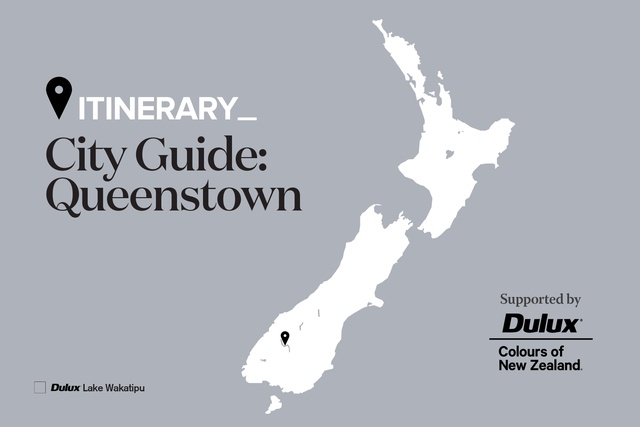
Gold was discovered in the Queenstown district in 1862. Prospectors flooded in and a makeshift canvas township appeared on the shores of Lake Wakatipu to service them. The area was constituted as a borough in 1866 but prosperity was fleeting. By 1870, miners had begun to disperse and, by the end of the century, the unspectacular industries of farming and mining were the area’s mainstays.
In the latter decades of the 20th century, tourism ramped up, gradually at first but steeply later, injecting a new prosperity. The town has retained its intimate scale and much of its heritage architecture, such that Queenstown is characterised by the historical and the contemporary sitting side by side. This might be thanks to both the constrained topography – the core of the town is small – and the unusual pattern of affluence: the sudden spike of the gold rush and the low hum of sheep farming, followed by the more sustained but equally lucrative rush of tourism. With no industry or even a milk factory to close down, the town took none of the economic hits that led to empty shops, main street demolitions and fractured streetscapes in other towns.
Affluence and opportunity have, of course, brought architects to the area. The 1970s saw the arrival of John Blair, first in the employ of Warren and Mahoney to supervise the Travelodge’s construction; he stayed on as the only architect resident in town. He became the local maestro and, capitalising on opportunities unusual in a small town, built a career of national significance. Blair’s office became an incubator, fostering other local talents such as Michael Wyatt. In more recent years, the district has become home to a concentration of significant female-led firms – Anna-Marie Chin Architects, Mary Jowett Architects, Salmond Architecture (led by NZIA Distinguished Fellow Anne Salmond) and Jackie Gillies + Associates, amongst others – as well as a number of husband-and-wife or mixed teams, such as Assembly Architects, Kerr Ritchie and Condon Scott Architects.
Queenstown’s architecture undoubtedly gains from its magnificent setting. Glistening Lake Wakatipu provides a beautiful waterfront; the heft and monumentality of the mountains, and the changing light they generate, inject any vista with drama. The geography is also, unsurprisingly, the main formal reference for many buildings: the jagged graph of mountain peaks – like the kete or the eel trap in other parts of the country – is amusingly unmissable as the region’s default architectural metaphor.
The town is not, however, without lessons to offer. Not much happened in Queenstown during the modernist years, so the wave of tourism-powered development took place in the context of fairly specific and vivid historical architecture, and of an architectural culture embracing the let’s-make-a-reference games of postmodernism. The results were mixed. There’s great architecture in central Queenstown: John Blair’s commercial work of the ’70s and early ’80s includes numerous under-appreciated gems. Other, less-gifted designers have resorted to using schist in the way children use tomato sauce – to give a little flavour to an otherwise bland morsel. Those in between have tended to work by taking various styles – miners’ cabins, colonial cottages, Renaissance villas, and the alpine architectures of Como and Colorado – and hollowing them out for reuse as sporting goods stores, tapas bars and real estate agents. It’s a kind of hermit crab approach to design, in which the discarded shells from another time and place are occupied by new inhabitants.
However, while it’s tempting to sniff at some wonky individual buildings, their collective effect is perhaps unique in New Zealand. The town has, thus far, maintained a human scale in its commercial architecture and is very walkable. It accommodates lively activity while protecting its very humble historic structures, absorbing the sometimes ostentatious new buildings and allowing some truly striking work to emerge along the way.
THE ITINERARY
01. 1863 – Lake Lodge of Ophir
13 Marine Parade, by Thomas Paterson and William Ford (builders)
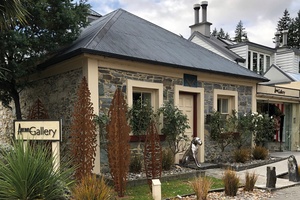
Following the discovery of gold, a canvas township sprang up on the shores of Lake Wakatipu. Within a year, leading citizens gathered to form a Masonic Lodge and, a few weeks later, laid the foundation stone for a building on the lake foreshore. It was the first stone building erected in the town – in a locale with little timber, it was a natural choice. Note the lantern on the roof, perhaps explaining why roof lanterns have become a local motif. A Category 1 Historic Place, the building is now an art gallery and a good portion of it can be visited.
02. c. 1866 – Williams Cottage
21 Marine Parade, by John Williams
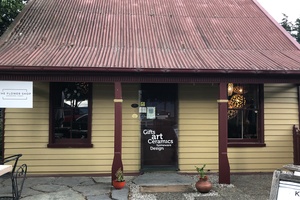
This Category 1 Historic Place is the oldest surviving cottage in Queenstown. It was built by John Williams, a boatman who established key shipping services across the lake, and was later owned by James McNeil, a stonemason who built some of the town’s key early structures. Still occupying prime waterfront real estate, the Cottage and the adjacent historic buildings stand as testament to Queenstown’s unpretentious beginnings during the gold rush era. The interior of the building is remarkably original – the old shingles are visible under the roofing on the porch – and, now it is a store, it can be quite thoroughly explored.
03. 1869 – Eichardt’s Private Hotel
2–11 Marine Parade, by Frederick Burwell
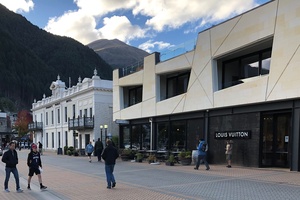
This Category 2 Historic Place stands on the site of the first building in Queenstown, a homestead built by William Rees, the ‘Father of Queenstown’. Rees soon converted this into a timber tavern and it passed into the ownership of Albert Eichardt, who rebuilt it in masonry to a design by Frederick Burwell. It was restored by Wyatt + Gray Architects and Salmond Reed Architects, winning an NZIA Resene Architecture Award in 2002. The 2016 extension, Eichardt’s II, is known colloquially as the ‘Louis Vuitton building’, referring to the luxury boutique on the ground floor. It also houses the office of its designers, Wyatt + Gray Architects.
04. 1876 – Courthouse and Library
45 Ballarat Street, by Frederick Burwell
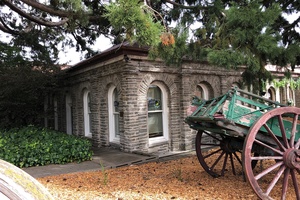
These Category 1 Historic Places were designed by Scottish-born Frederick Burwell, who lived for some years in Queenstown but, later, made significant contributions in Invercargill and various Australian cities, including Freemantle. The Courthouse was built first in 1876 – the year the now-gigantic Wellingtonia Pines were planted – and the Library (Athenaeum) the following year. They were rescued from demolition in the 1960s and are now home to a Citizens Advice Bureau and the aptly named 1876 bar and restaurant. Burwell enthusiasts might make the drive to his St Patrick’s Catholic Church (1874) at 7 Hertford Street in Arrowtown.
05. 1881 – Old Lake County Council Chambers
50 Ballarat Street, by Frederick Burwell
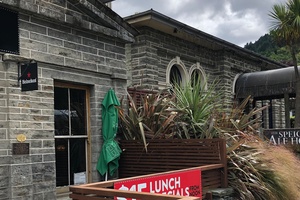
As with his earlier Courthouse and Library across the street, Burwell combined schist stone and Romanesque motifs. Council meetings were apparently wild affairs marked by ‘riot and violence’. There was heated opposition to the construction of the Chambers but its completion was a key marker of Queenstown’s evolution from gold rush encampment to settled town. Now both a Category 2 Historic Place and a Speight’s Ale House, the building was constructed by stonemason James McNeil (see listing 02), who also built the Ballarat Street Bridge down the block in 1882. Next to the bridge is Boffa Miskell’s Queenstown Village Green (1994).
06. 1888 – Hulbert House
68 Ballarat Street, by Mason & Wales Architects
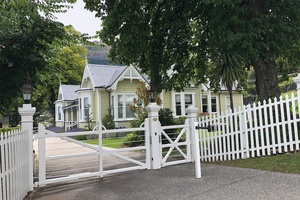
Established in 1863, Mason & Wales Architects is the nation’s longest-surviving architectural firm. This house also has a colourful history: one that encapsulates the whole arc of Queenstown’s development. It was built for Queenstown’s official Mining Registrar, who was, soon after, imprisoned for embezzlement. His wife then ran it as a boarding house and, over the years, it was used as a private nursing home, a maternity home, a guest house, a bed and breakfast, and a backpackers’; now, it is a swanky boutique hotel. See hulberthouse.co.nz for bookings. Nearby, at 11 Henry Street, is the Commercial Building (1988), now Tahuna Pod Hostel, by Max Wild, another local notable.
07. 1898 – St Joseph’s Catholic Church
41 Melbourne Street, by Francis Petre
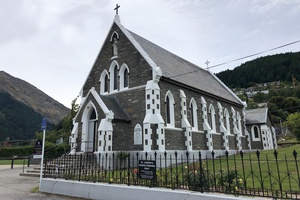
This Gothic Revival charmer was built from local schist and rimu to the design of Wellington-born architect Francis Petre. After training in London, Petre returned to New Zealand and worked on railway lines in the South Island before setting up a practice in Dunedin as an architect and civil engineer. He became known for churches and cathedrals, including St Joseph’s Cathedral, Dunedin (1886), Cathedral of the Sacred Heart, Wellington (1901), and the now-demolished Cathedral of the Blessed Sacrament, Christchurch (1905). Petre admirers should see the Catholic Church of Mary Immaculate and the Irish Martyrs (1909) in Cromwell.
08. 1932 – St Peter’s Anglican Church
2 Church Street, by Henry McDowell Smith
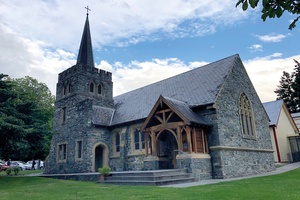
Replacing a wooden building erected in 1863, this quaint timber and stone church was designed by architect Henry McDowell Smith in 1926, although construction didn’t proceed until 1932. Smith practised in Dunedin and was, for a time, a business partner of Edmund Anscombe. In independent practice, he is best known for the grand Hudson House in Dunedin, built for the family whose confectionery empire was eventually taken over by Cadbury. Next door is the former vicarage, dating from 1869 and the second-oldest wooden building in town, and the 1905 Church Hall. All are Category 2 Historic Places.
09. 1968 – St Andrew’s Presbyterian Church
26 Stanley Street, by Miller, White & Dunn
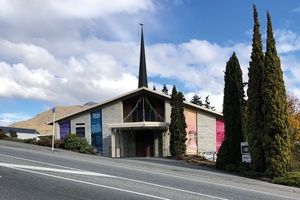
An austere composition in concrete block and river stones, the main space is sheltered under a subtly twisting roof. It was completed by long-running Dunedin firm Miller, White & Dunn.
They are best known for much flashier buildings in Dunedin, such as art-deco tour de force NZ Railways Road Services building (1939) and the brutalist towers of John Wickliffe House (1977). Fans of Presbyterian architecture might also like to visit Frederick Burwell’s St John’s Church (1880) at 26 Berkshire Street, Arrowtown. Alternatively, those seeking urgent rest might step across the road to McAuliffe Stevens’ Holiday Inn Express & Suites (2019) on Sydney Street.
10. 1975 – Crowne Plaza Queenstown
Beach Street, by Warren and Mahoney
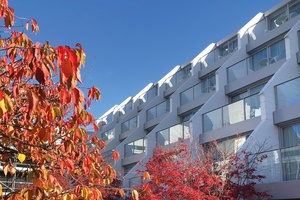
Originally a Travelodge, this hotel was one of the last in Warren and Mahoney’s series of constructivist projects. The lobby and rooms have been refurbished over the years (by John Blair Architect in 1993 and by Dalman Architects in 2007) but the building’s bold form still sits magnificently in the townscape and the vertiginous circulation spaces retain their original verve. It’s worth noting that John Blair first came to the region in the employ of Warren and Mahoney to supervise the hotel’s construction, staying on as the only architect resident in town to become the local maestro and, eventually, build a career of national significance.
11. 1984–2003 – Camp and Shotover Intersection
Corner Camp and Shotover Streets, by John Blair Architect; Michael Wyatt Architects
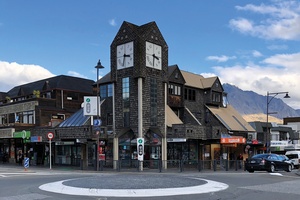
The corners of this intersection are occupied by four separate buildings, two each by the two most prominent local architects. The urban ensemble includes John Blair’s shingle-style Clock Tower building (1984) to the south and his Chester Building (1986) to the north. The Station (1990s) and The Forge building (2003) by Michael Wyatt (who had worked for Blair) stand to the west and east, respectively. Together, the buildings showcase various strands of postmodernism found in town – Blair’s picturesque, context-driven shingle style and his signature geometricism, and Wyatt’s assertive classicism and his gentler, more eclectic pomo sampling.
12. 1995 – Steamer Wharf 88
Beach Street, by Michael Wyatt Architects
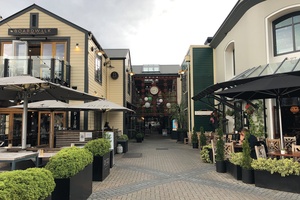
An integral part of the Queenstown waterfront, Steamer Wharf is one of Wyatt’s most well-known projects. Reminiscent of boat sheds partially suspended over the lake, its village-like feel is a deliberate choice, as a development of this size might easily have felt overwhelming in Queenstown. Winner of an NZIA Resene Southern Branch Award in 1995, this collection of bars and restaurants is a hub for locals and tourists alike. To see Wyatt’s work at a smaller scale, visitors can head further up Beach Street to the Earnslaw Park toilets (2013). Stroll further up to
8 Ballarat Street to see Maurice Orr’s BONZ building (1994).
13. 2006 – Queenstown Resort College
7 Coronation Drive, by Michael Wyatt Architects
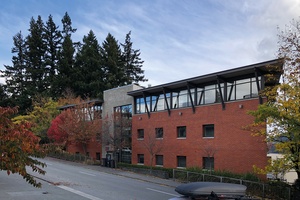
In honouring this project with an NZIA Resene Architecture Award in 2007, the jury wrote: “This modest-scale commercial development fits comfortably in its urban surroundings and makes the most of its awkward, steeply sloping triangular site. The resulting structure belies its five levels. The brick cladding, an unexpected material in Queenstown, relates well to its setting adjacent to the densely treed reserve and the chunky pre-cast concrete frame to the southwest corner anchors the building to the site. Sunshades to the western elevation help control solar gain as well as providing further visual texture to an otherwise solid wall.” See Architecture NZ May/June 2007.
14. 2010 – Church Street Development
11 Church Street, by +MAP
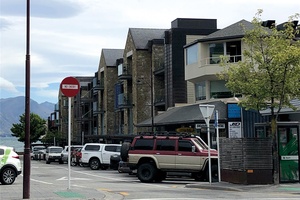
This four-story mixed-use development seeks to marry almost every aspect of the region’s architectural vocabulary – the old schist cottages, contemporary steel-framed houses, metal-skinned agricultural architecture, and the super-heavy timber structures of the area’s mines and wharves. That’s a big ask but the composition holds together; the crisply gabled forms in stone, glass and steel balconies, and huge timber frames (each element must have been a whole tree), have weight and authenticity that is missing in many other local buildings that attempt the same feat. It was the winner of an NZIA Southern Architecture Award in 2011. Tip: The Japanese noodle bar on the ground floor is worth the wait.
Worth the drive
Chinese Miners’ Huts (1860s) – Buckingham Street, Arrowtown.
Arrowtown Library (1985) – 58 Buckingham Street, Arrowtown, by Michael Wyatt Architects.
Chard Farm Winery (1993) – 205 Chard Road, Gibbston, by Custance & Associates.
Amisfield Winery and Bistro (2002) – 10 Lake Hayes Road, Lake Hayes, by Warren and Mahoney.
AJ Hackett Kawarau Bungy Centre (2003) – 1693 Gibbston Highway, Gibbston, by Patterson Associates.
Peregrine Winery (2003) – 2127 Gibbston Highway, Gibbston, by Architecture Workshop.
Wakatipu Ski Club (2008) – Coronet Peak , by John Blair Architect.
Frankton Terminus (2010) – State Highway 6, Frankton, by Mary Jowett Architects.
Remarkables Primary School (2010) – 49 Lake Avenue, Frankton, by Babbage Architecture.
The Shed and The Barn (2018) – 4 Buckingham Street, Arrowtown, by Maurice Orr.
Aosta (2019) – 18 Buckingham Street, Arrowtown, by Anna-Marie Chin Architects.
Abodo Cardrona Showroom (2020)– 2340 Cardrona Valley Road, Cardrona, by Assembly Architects.
Te Kano Estate Cellar Door (2020) – 92 Felton Road, Bannockburn, by Mason & Wales Architects.
The itinerary series is supported by Dulux Colours of New Zealand. Dulux Colour Specialist Davina Harper has selected a Colours of New Zealand palette based on this itinerary. See the full range and order colour samples here.

Sources
Various aspects of Queenstown’s architecture are covered in our history books. Have a look in John Stacpoole’s Colonial Architecture in New Zealand (Wellington: A H & A W Reed, 1976), Peter Shaw’s New Zealand Architecture (Auckland: Hodder & Stoughton, 1991) and Frances Porter’s (ed.) Historic Buildings of New Zealand: South Island (Auckland: Methuen Publishing, 1983). The Heritage New Zealand database is a great resource for older projects: heritage.org.nz. The late Jonathan Mane-Wheoki wrote an entry on Frederick Burwell (1846–1915) in Jane Thomson (ed.), Southern People: A Dictionary of Otago Southland Biography (Dunedin: Longacre Press, 1998). A healthy chunk of Queenstown’s later architectural history is covered in John Balasoglou’s John Blair: Architect (Auckland: NZ Architectural Publications Trust, 2010). For a useful profile of three Queenstown architects – Max Wild, Alan Poor and Gillian Macleod – see Nick Karlovsky’s ‘The Queenstown Connection’, Architecture NZ Sept/Oct 1988. An overview of several of Michael Wyatt’s projects can be found in Architecture NZ Jul/Aug 1994.









